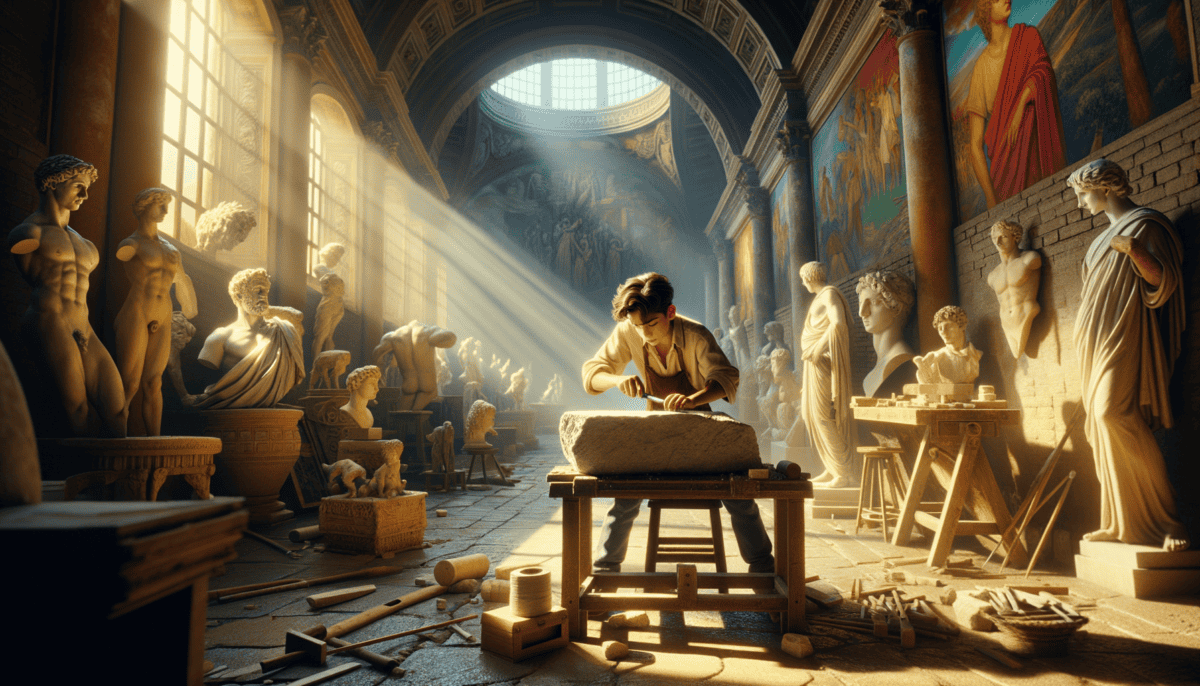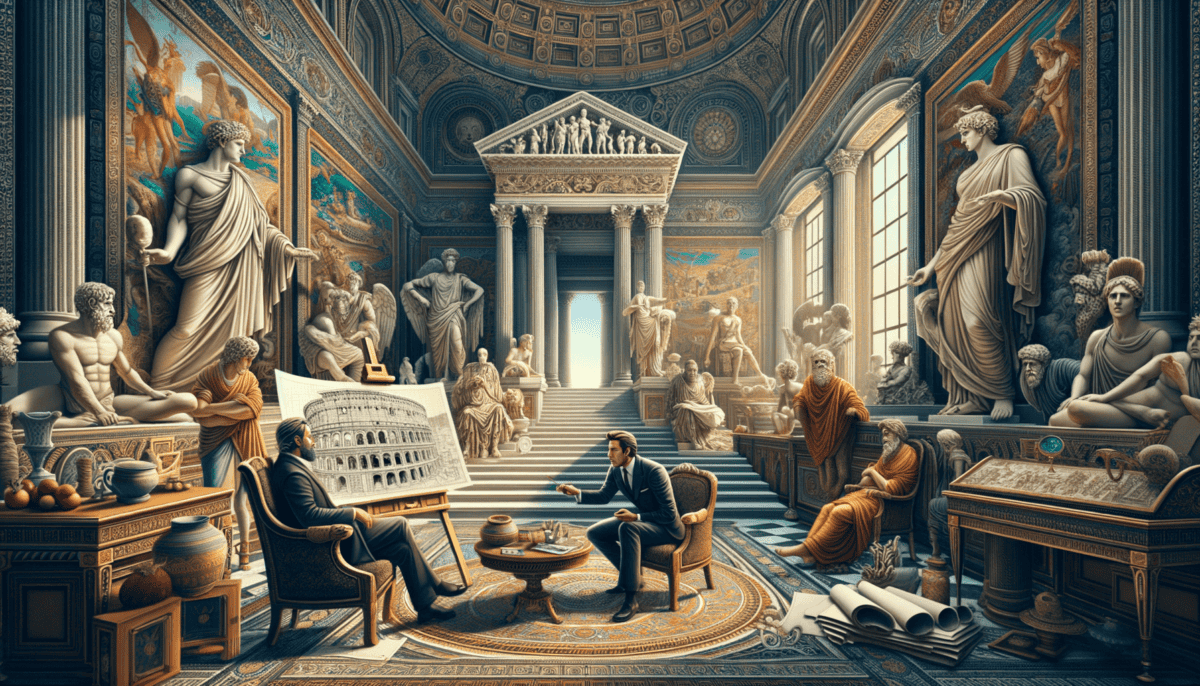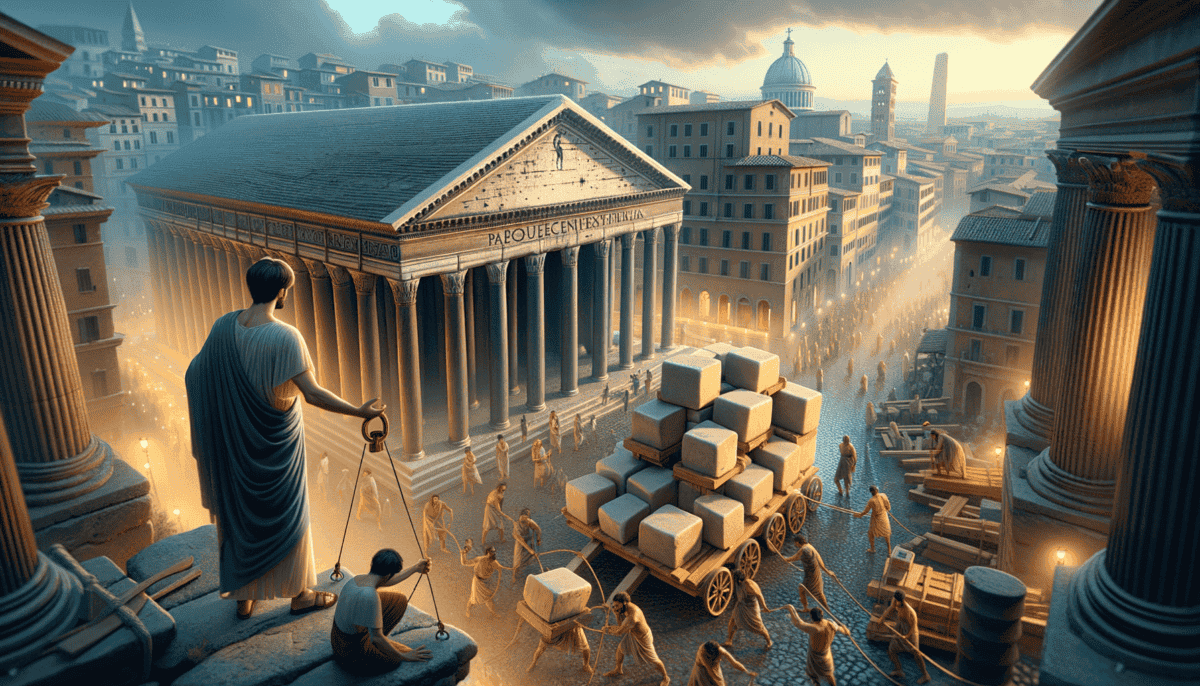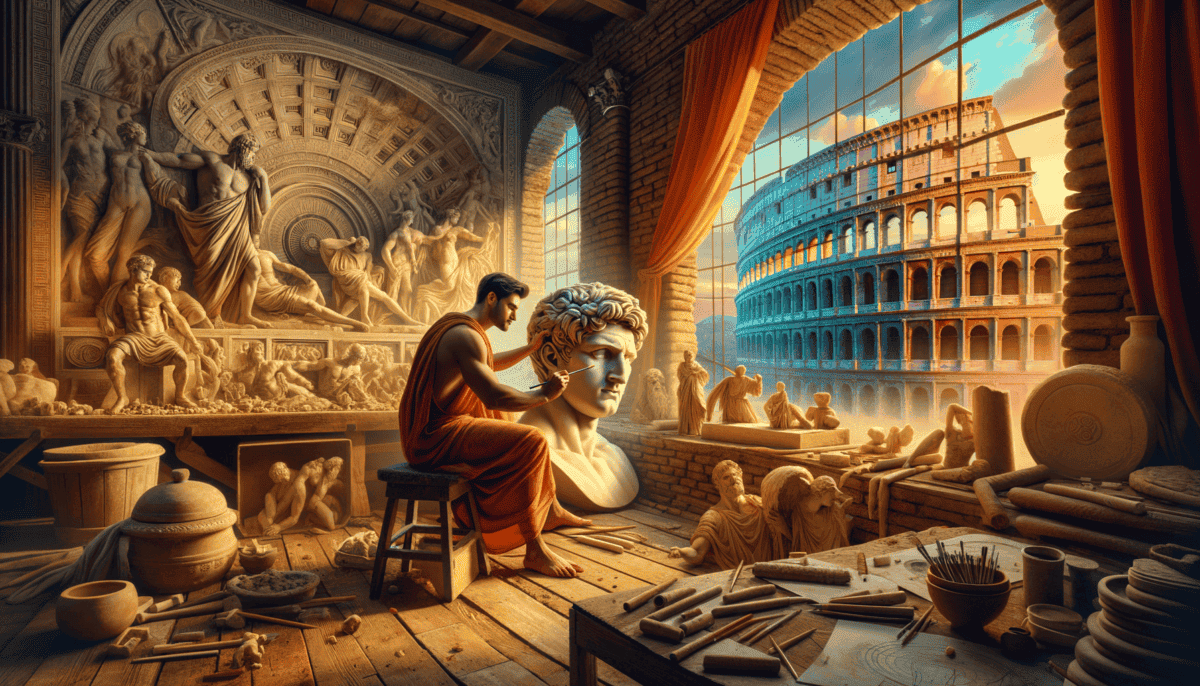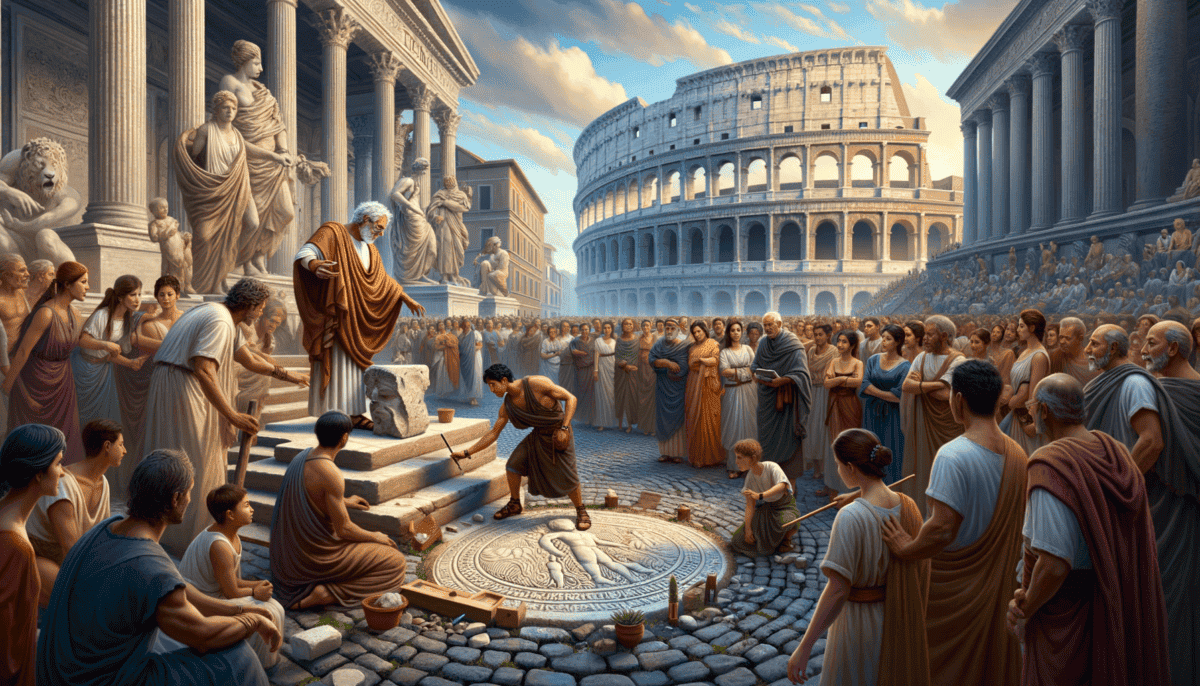The Young Artist’s Dream
The morning sun sparkled over the busy streets of Rome. Marco stood at his father's workshop, his small hands covered in white dust. He was trying to shape a block of marble, just like his father taught him.
"Remember, son," his father said, wiping sweat from his brow, "every piece of stone has a story waiting to be told."
Marco nodded, his dark curls bouncing as he concentrated. At twelve years old, he was the youngest apprentice in the workshop. His father was Rome's best stone mason, known for his skill in cutting perfect blocks for the city's grand buildings.
The workshop buzzed with activity. Hammers tapped against chisels, and stone dust filled the air like morning mist. Marco loved watching the older workers turn rough blocks into beautiful shapes.
"Papa," Marco called out, "I want to make more than just building blocks. I want to create art that tells stories!"
His father smiled warmly. "Then you must learn from the beginning, little one. Even the greatest sculptors started by understanding their stone."
That afternoon, something exciting was happening in Rome. The streets filled with people celebrating the summer festival. Colorful banners waved in the breeze, and music filled the air.
Marco watched in wonder as dancers twirled past the workshop. Without thinking, he grabbed a small piece of clay and began to shape what he saw. His fingers moved quickly, capturing the movement of the dancers.
"Marco!" a voice called. It was Claudia, his older sister. "What are you making?"
He held up his little clay sculpture. It showed three dancers, their bodies curved in graceful poses. Even though it was small and rough, you could almost see them moving.
Other workers gathered around to see. Their eyes widened with surprise. Marco had captured something more than just shapes – he had caught the spirit of the dance itself.
Marco could hardly sleep that night. His mind raced with images of all the beautiful things he could create. Through his window, he could see the moonlight playing on the marble columns of the temple across the street.
He thought about the stories his grandmother told him about the great artists of Greece, who made statues so lifelike they seemed to breathe. Maybe someday, he too would create something that amazing.
“Art is magic,” his grandmother always said, “It lets us capture moments forever in stone.”
As dawn approached, Marco finally drifted off to sleep, dreaming of the sculptures he would create. In his dreams, marble dancers twirled through the streets of Rome, and stories came alive in stone.
Tomorrow would bring new challenges, but Marco was ready. His journey from stone mason's son to artist had begun, and the ancient city of Rome would be his teacher. ️
Lessons from the Masters
The morning breeze carried the sound of chisels through the streets of Rome. Marco hurried along the cobblestones, his heart racing with excitement. Today was his first day studying with Alexandros, the famous Greek sculptor.
"Welcome, young one," Alexandros smiled, his beard streaked with white. His workshop was filled with beautiful statues, some tall as trees. Marco's eyes grew wide with wonder.
Alexandros handed Marco a small piece of clay. "Show me what you can do," he said kindly. Marco's fingers moved quickly, remembering the dancers from the festival.
"Interesting," Alexandros murmured, watching Marco work. "You have natural talent, but talent alone is not enough. You must learn the old ways first."
Day after day, Marco learned new things. He discovered how to make faces look real and clothes seem to flow like water in stone. Sometimes his hands got tired, and his back ached from standing all day.
“Each mistake teaches us something new,” Alexandros would say when Marco got frustrated. “Even the greatest masters were once beginners.”
One morning, Alexandros showed Marco something special – a secret room full of broken pieces of old Greek statues. "These are our teachers," he said. "Study them well."
Marco spent hours drawing the ancient pieces, learning how the Greek artists made their masterpieces. But sometimes, he felt trapped by all the rules. His hands wanted to create new things, different things.
Alexandros smiled. "Now you begin to understand. First learn the rules, then make them your own. Show me what you mean."
Excited, Marco began work on a new sculpture. He combined the grace he learned from Greek art with the power he saw in Roman buildings. For days, he worked from sunrise to sunset.
Finally, it was ready – a statue of a Roman soldier, but not in battle. Instead, the soldier was helping a child cross a busy street. The figure had the perfect balance of Greek statues, but with a uniquely Roman story.
"You see?" Alexandros beamed. "You've taken what I taught you and made something new. That's what art is all about."
That evening, as Marco walked home, he saw his city differently. Every column, every statue had a story to tell. He was beginning to speak their language, and soon he would add his own voice to Rome's great artistic chorus. ️
His father was waiting at home. "How goes your training?" he asked.
Marco smiled, his hands still dusty with marble. "I'm learning that art is like building – you need a strong foundation before you can reach for the sky."
As stars appeared over Rome's seven hills, Marco sketched new ideas in his tablet. Tomorrow would bring more lessons, more challenges, but he was ready. His journey from student to artist was just beginning. ⭐
The Imperial Commission
The summer sun blazed over Rome as Marco rushed through the crowded streets. A messenger had brought exciting news – Senator Claudius wanted to see his work! ️
“Stand tall,” Alexandros whispered as they entered the senator’s grand villa. Marble columns reached to the sky, and colorful paintings covered every wall.
Senator Claudius sat on a golden chair, wearing a bright purple toga. “So, this is the young artist I’ve heard about?” His eyes sparkled with interest.
“Yes, Senator,” Marco said, trying to keep his voice steady. He showed the drawings he had brought. His hands shook a little, but he remembered what his father taught him about being brave.
Marco’s heart jumped with joy. “I would be honored, Senator! I have an idea for a fountain with sea creatures that could…”
“Not just any fountain,” the Senator interrupted. “I want something that shows Rome’s greatness. Something that tells our story!”
For days, Marco couldn’t sleep. He drew picture after picture, trying to find the perfect design.
• Water flowing like Roman roads
• Symbols of Roman power
• Stories of Roman heroes
• Hidden details for people to find
“What if it doesn’t turn out right?” Marco worried to Alexandros one morning.
“Every artist feels fear,” his teacher said kindly. “But great art comes from facing that fear.”
Work began on the fountain. Marco learned to lead other workers, teaching them how to cut the stone just right. Some days were hard, and his arms ached from lifting heavy tools.
One day, a worker dropped a carved wolf’s head, breaking it. Marco felt like crying, but instead, he took a deep breath. “We’ll make an even better one,” he said with a smile.
Weeks passed. The fountain grew taller and more beautiful. Water flowed through channels shaped like rivers. Stone dolphins seemed to dance in the spray. Children playing nearby would stop to watch the workers, pointing at new details they spotted.
Finally, the big day arrived. Senator Claudius came to see the finished fountain. Marco held his breath as the water started flowing for the first time.
“By Jupiter!” the Senator clapped his hands. “This is more than I dreamed possible. You’ve captured the spirit of Rome itself!”
Marco beamed with pride. Looking at his creation, he saw more than just stone and water. He saw his own story too – a boy becoming an artist, learning to believe in himself.
That evening, as the sun set behind the seven hills, people gathered around the new fountain. Children splashed in the cool water, and old men pointed out the stories carved in stone.
“You’ve done well,” Alexandros said softly. “But remember, this is just the beginning. Rome has many more stories waiting to be told.” ⭐
Marco nodded, already dreaming of his next creation. The fountain had taught him something important – art wasn’t just about making beautiful things. It was about bringing people together and sharing stories that would last forever.
Architectural Wonders
Marco wiped sweat from his brow as he looked up at the massive building project before him. After his success with the senator’s fountain, he had been invited to help design a new public bathhouse. ️
“But how will the roof stay up?” Marco asked, looking at the huge open space in the plans. “It’s so wide!”
Vitruvius smiled and pulled out a strange mixture. “With this – our secret weapon. We call it concrete!”
He showed Marco how to mix sand, tiny rocks, and a special powder with water. Soon, they were making test blocks together. ️
“You see, young artist, architecture is like sculpture, but people can walk inside it!” Vitruvius laughed.
• They used arches to make things stronger
• Windows let in lots of light
• Heated floors kept people warm
• Beautiful decorations everywhere
But not everyone liked their new ideas. One morning, a group of old-fashioned builders came to complain.
“This isn’t how we’ve always done things!” they shouted. “Buildings should be made of stone, not this concrete stuff!”
Marco felt scared, but Vitruvius stood tall. “Rome grows stronger when we try new things. Come back in a month, and you’ll see!”
His favorite part was adding art to the walls. He carved beautiful patterns into the wet concrete and designed colorful mosaics for the floors.
One day, while Marco was working on a ceiling design, his chisel slipped. Instead of making a mess, the accident created a pretty new pattern!
“Sometimes mistakes lead to the best discoveries,” Vitruvius said with a wink.
As the bathhouse grew taller, people started gathering to watch. Even the doubtful builders came back to see. Their angry faces turned to looks of wonder when they saw the huge dome taking shape.
“How does it stay up?” they asked, amazed.
“It’s like an egg,” Marco explained proudly. “The shape makes it strong!”
Finally, after many months of hard work, the bathhouse was ready. Water flowed through clever pipes, steam rose from heated pools, and sunlight danced through the round window in the dome.
People gasped when they walked inside. “It’s like being in a palace!” they said.
Marco smiled, touching the warm walls he had helped create. His art wasn’t just pretty anymore – it was useful too. People would come here every day to relax, talk, and enjoy the beauty.
“You’ve learned well,” Vitruvius said. “Now you understand – architecture is art that people can live in.”
That night, Marco sat drawing new building ideas by candlelight. ️ He thought about all the amazing things Romans could build with concrete, arches, and imagination. The city was growing, and he would help make it more beautiful than ever!
The Weight of Memory
The streets of Rome buzzed with worry. Enemy armies were getting closer to the city. Marco watched as soldiers marched past his workshop, their armor gleaming in the morning sun. ⚔️
Marco’s heart felt heavy. His friend Felix had joined the army last month. Now he had to make art about war, not just beautiful buildings.
He started working on a special wall of carvings. It would show brave Roman soldiers protecting their homes. But instead of making them look scary, he showed their kind faces and strong hearts. ️
“Look here,” Marco told his young helper. “See how this soldier is sharing bread with a child? That’s what we’re really fighting for.”
• Pictures carved in stone
• Painted scenes on walls
• Statues of heroes
• Beautiful medals
One day, sad news came. Some enemy soldiers had burned artwork in a nearby town. Marco felt angry, but then he had an idea.
“We can make copies of important art!” he said. “That way, if something happens to one, others will still exist.”
A letter arrived from Felix on the battlefield. “Your memorial wall gives us strength,” he wrote. “When we feel tired, we remember why we fight.”
Marco worked harder than ever. He carved scenes of farmers growing food, children playing games, and families sharing meals. These were the everyday moments worth protecting.
As he worked on the column, Marco thought about what made art important. It wasn’t just about making pretty things – it was about keeping memories alive.
He carved faces of real soldiers he knew. He showed their courage, but also their kindness. “This is who we really are,” he said proudly.
When Felix came home, he brought Marco a gift – a small piece of marble from a far-away land. Together, they added it to the memorial wall.
“Now our art connects us to the whole world,” Marco smiled.
Other artists started coming to Marco for advice. He taught them how to tell stories through their work, just like his teachers had taught him.
“Remember,” he would say, “we don’t just make art. We keep memories safe for the future.”
One evening, Marco sat sketching by the victory column. A little girl pointed at his drawings. “What are you making?” she asked.
“I’m making memories,” he answered. “Would you like to learn how?”
As the sun set over Rome, Marco knew his art would help people remember these important times forever. Each carving, each statue, each painted wall told a piece of their story.
A Legacy in Stone
Years had passed, and Marco’s beard now had streaks of gray. His workshop buzzed with the sounds of young artists learning their craft.
“Tell us about your biggest project ever!” young Julia begged, her eyes sparkling with excitement.
Marco smiled, laying down his chisel. “The Emperor himself has asked for something special – a giant statue for the new public square.”
His students gathered around as he sketched his ideas. The statue would show people from all parts of Rome – soldiers, farmers, artists, and children.
“Art brings people together,” Marco told them. “It helps us understand each other’s stories.”
• Be patient with your work
• Tell true stories
• Put your heart into every piece
• Learn from others
Felix, now a decorated general, visited the workshop. His son was one of Marco’s newest students.
“Look how far you’ve come, old friend,” Felix said, admiring the workshop. “From a young apprentice to Rome’s greatest teacher.”
The big statue took many months to complete. Everyone in the workshop helped. Young artists carved details while Marco guided their hands.
“Each person who touches this statue adds their own story to it,” he said proudly.
Finally, the day came to show the statue to Rome. The square was filled with people. Marco stood with his students, watching their faces light up. ✨
The Emperor himself came to see it. “This is more than art,” he declared. “This is our story in stone.”
That evening, Marco sat with Julia, his most promising student. “What will you create when you’re a master?” he asked.
“I want to make art that tells new stories,” she said. “Just like you taught me.”
Marco looked at the statue glowing in the sunset. He thought about all the hands that had helped shape it.
“The greatest art comes from many hearts working together,” he said softly. “That’s how Rome’s beauty will live forever.”
Years later, people would still stop to admire Marco’s statue. Children would point and ask about the stories carved in stone.
And in workshops across Rome, new artists would learn the lessons Marco taught – that art is a way to share our stories, connect our hearts, and make memories that last forever.
The little owl he carved still watches over the square, reminding everyone that every great artist started as a student, and every piece of art carries a piece of its maker’s spirit.
Marco’s legacy lived on, not just in stone and marble, but in the hands and hearts of every artist he taught, and every story they would tell.


